The wonderful capabilities of chlorine
by habiba_abudu | April 14, 2019 7:42 pm
By Terry Arko
Earn 25 credits towards the Pool & Hot Tub Council of Canada’s ( PHTCC’s) Industry Trade Certification Program by completing the quiz. [1]
 [2]
[2]In 1774, a chemist named Carl W. Scheele conducted an experiment in his pharmacy laboratory in Sweden that led to the discovery of chlorine. Scheele treated a sample of manganese dioxide with hydrochloric acid that resulted in the formation of a yellow pungent gas. After Scheele picked himself up from the floor, he realized he was onto something.
Thirty-five years later, the famed English chemist Sir Humphrey Davy established this gas as a new element. Davy named the gas after the Greek word “khloros” meaning green. Chlorine appears as number 17 on the periodic table of elements. When combined with the metal sodium it produces common salt (sodium chloride). Chlorine is classified as a halogen (salt former).
Passing electricity through a solution of sodium chloride creates a gas of hypochlorous acid HOCl. The process leaves behind a liquid byproduct of hydrochloric acid, also known as muriatic acid. When exposed to air, chlorine becomes a yellow gas that is two-and-a-half times heavier than air. Chlorine gas in air has a very pungent odour and is irritating to mucous membranes.
One of the first uses of chlorine gas industrially was in 1915 as a weapon in World War I. Because of its density, the gas quickly sank down into the trenches. The result would be severe choking and blindness and in some cases death.
A beneficial use for chlorine came about earlier in London. In the 1800s there were more than 25,000 deaths in less than a decade, due to cholera from raw sewage in the River Thames. In 1855, London became the first city in the world to treat sewage with the disinfectant chlorine. It reduced the cases of cholera to nearly zero. The first use of chlorine in North America, as a disinfectant for drinking water was more than 110 years ago. In 1908, most experts considered the addition of chloride of lime for treating 151,416,471 L (40,000,000 gal) of drinking water to be preposterous, dangerous, and illegal. Despite the objections, the first use of chlorine to disinfect a city drinking water supply took place in Jersey City, New Jersey. It was Dr. John L. Leal who came up with the simple idea of disinfecting a public water system with chlorine. He was a pioneer in public health that led to more lives saved than any other single health development in human history.
The use of chlorine for drinking water in the United States, for example, reduced the annual number of cholera cases from 25,000 in 1900 to 20 in 1960.
Chlorine became popular for pool use in the 1920s. A form of calcium hypochlorite containing 70 per cent available chlorine, and known as high-test hypochlorite (HTH), became available in 1923. This form of chlorine became very popular as a bleaching agent, as well as a sanitizer for pool water, and production increased rapidly.
In 2000, Life magazine called the use of chlorine as a disinfectant in water one of the most important inventions of the last 1000 years.
Earn 25 credits towards the Pool & Hot Tub Council of Canada’s ( PHTCC’s) Industry Trade Certification Program by completing the quiz. [1]
How chlorine works in water
Water is one of the most powerful and reactive elements on earth. It consists of one oxygen molecule and two hydrogen molecules that form an angle of 105 degrees. This arrangement of H2O results in a polar molecule because it contains positive and negative electrons. This creates an extremely strong connection between the molecules known as hydrogen bonding, which is what holds water together and gives it a ‘skin’ at the surface.
Water is the ‘universal solvent’ and can contain small amounts of dissolved minerals. It can erode and dissolve rock and sand, and is also capable of absorbing and precipitating minerals as needed. Water will always naturally seek a balance. Further, water is an active chemical that reacts with salts to form bases and with certain metal oxides to form acids. One of its key characteristics is its ability to absorb and transport all types of detritus—including contaminant waste from humans and animals. As a result, water can unknowingly be a holder of disease causing bacteria and viruses.
It can also harbour chlorine-resistant protozoa such as cryptosporidium (crypto).
Outdoor pools are subject to an onslaught from the surrounding environment (e.g. dust, dirt, pollen, plant materials, and insects) as well as contamination from wildlife (e.g. birds, waterfowl, and other vagrant wildlife). Indoor pools are not subject to the same constituents; however, the biggest challenge for all types of pools is the fact that people enter the water.
Swimmer contamination is the largest opposition to keeping pools clean, safe, and sanitary. Humans carry a lot of ‘stuff’ that can slough off and be absorbed into the water. Even the cleanest of persons still carry millions of bacteria on his/her body. Here is a list of some:
- 38,000 micro-organisms released with clearing the nose;
- 100 million to 1 billion organisms from one spit of saliva in the pool;
- 938 mL (33 fl oz) of perspiration released in the pool per hour;
- 5 million organisms shed from a single handwashing;
- one tenth of a gram of fecal material on showered swimmers; and
- every time a swimmer enters the pool millions of contaminate particles are shed. It is for this reason that chlorine plays a key role in the disinfection
of pools.
Earn 25 credits towards the Pool & Hot Tub Council of Canada’s ( PHTCC’s) Industry Trade Certification Program by completing the quiz. [1]
Disinfection versus oxidation
 [3]
[3]While chlorine acts as an oxidizer, its main role is killing disease-causing micro-organisms.
Chlorine is one of only two sanitizers registered with Health Canada’s Pest Management Regulatory Agency (PMRA).
Chlorine is the most common chemical used in pools. The main reasons for this are cost and efficiency. Chlorine is one of only two sanitizers (bromine) registered with Health Canada’s Pest Management Regulatory Agency (PMRA) and meets the requirements of an Environmental Protection Agency (EPA) approved disinfectant.
There are three main requirements of a regulated and approved disinfectant. First, the chemical must kill 99.9 per cent of disease causing organisms. Second, it must have the ability to oxidize non-living contaminant waste. Lastly, it must be able to leave a measurable residual behind in the water. Because it is a halogen, chlorine disinfects and oxidizes.
Disinfection, also referred to as sanitizing, is the effective killing of germs. Oxidation is the destruction of particulate non-living waste materials like skin and hair follicles. The primary reason for chlorine use is to protect swimmers from common maladies such as pink eye, earaches, and skin rashes. Further, protection includes the effective inactivation of E.coli, Giardia, and Hepatitis A.
One germ chlorine has a difficult time dealing with is Crypto. It can take more than 10 days to inactivate this parasite in a pool with 1 parts per million (ppm) of chlorine with a pH of 7.5. Chlorine inactivates most other germs within seconds to minutes with the proper residual. While chlorine acts as an oxidizer, its main role is killing disease-causing micro-organisms. Therefore, having an additional means of oxidation in place can help to ensure the most effective removal of threatening germs.
Incorporating additional and pro-active oxidation using the non-chlorine oxidizer shock product potassium monopersulfate (MPS) is one method. The use of either ozone or ultraviolet (UV) light is another proactive oxidation method that ensures cleaner water. In short, the purpose for adding chlorine is primarily to kill. Additional oxidation methods can help ensure this purpose is effectively accomplished.
Earn 25 credits towards the Pool & Hot Tub Council of Canada’s ( PHTCC’s) Industry Trade Certification Program by completing the quiz. [1]
Like water, chlorine is also a very reactive chemical. Anytime chlorine and water meet very rapid reactions take place as follows:
Cl + H2O = Hypochlorous Acid (HOCl)
HOCl is the secret agent that does the killing of micro-organisms. Water, almost instantaneously, begins its job of ionizing and hypochlorite ions (-OCl) are produced.
Cl + H2O = HOCl + -OCl
When it comes to effectively killing germs and protecting swimmers, HOCl is the muscle providing 99 per cent power. The –OCl is weak, as it only provides one per cent power. Therefore, since the sole purpose of chlorine in pools is to keep swimmers safe from diseases, it goes without saying that there needs to be a majority of HOCl present.
What is the best way to accomplish the effective level of killing agent chlorine? Just as in life, for water chemistry to work, there must be balance. The presence of HOCl in pool water is dependent on where the pH level lies. High pH will mean a minimum of strong killing HOCl, while lower pH will give more killing agent HOCl. For instance, if the pH level is 8 there is only 24 per cent of HOCl killing agent in the water. There is 66 per cent HOCl in the water at a pH of 7.2. At the ideal pH level of 7.5 there is 50 per cent of both the HOCl and –OCl. Remember everything is about balance.
Which type of chlorine should be used?
After its immediate reaction of disinfecting and oxidizing, an initial byproduct is left behind in the water. The byproduct left behind, however, is dependent on the type of chlorine being used as the primary sanitizer.
Inorganic
Chlorine gas
Calcium hypochlorite (cal hypo)
Sodium hypochorite
Organic (Stabilized)
Trichlor
Dichlor
Cal hypo leaves calcium as the initial byproduct in the water. In fact, (0.45 kg [1 lb] of cal hypo increases the hardness by 4 parts per million [ppm] in 37,854 L [10,000 gal] of water). Stabilized forms of chlorine contain cyanuric acid (CYA). For every 0.45 kg (1 lb) of Trichlor, there will be 7 ppm of CYA left in 37,854 L (10,000 gal) of water.
Liquid chlorine is sodium hypochlorite that leads to sodium chloride being left behind as a byproduct. This causes an increase of total dissolved solids (TDS).
Earn 25 credits towards the Pool & Hot Tub Council of Canada’s ( PHTCC’s) Industry Trade Certification Program by completing the quiz. [1]
With the exception of chlorine gas, most inorganic forms of chlorine are base and have a higher pH. These forms of chlorine are more favoured and cost effective when used in geographic areas where the natural fill water is soft. Soft water is low in minerals, which means the water naturally craves calcium and other minerals. Additionally, total alkalinity and pH of soft source waters tends to be lower. It makes more sense to use disinfectants that will be adding what the water craves while also adjusting the total alkalinity and pH upwards.
Trichlor and dichlor are two acidic types of disinfectant and these may be preferred in areas where source water is hard. Hard water means the source is naturally high in calcium and other minerals. Calcium hardness as well as alkalinity and pH may run higher from the tap in these areas. Since trichlor and dichlor contain cyanuric acid stabilizer, they tend to have an effect in lowering alkalinity and pH.
In outdoor pools, the organic forms of chlorine that contain CYA may be preferred because of the presence of a stabilizer that protects against the destruction of HOCl by ultraviolet (UV) sunlight. Again, it is important to note, trichlor and dichlor will leave behind CYA (typically 6 to 7 ppm) per pound of product used in 37,854 L (10,000 gal). The levels of CYA recommended to ensure proper disinfection from chlorine are between 30 and 50 ppm. It is important to test and monitor CYA as extreme high levels may lead to poor disinfection and an interference with total alkalinity readings.
The benefits of chlorine
 [4]
[4]Chlorine is one of the best choices for disinfecting pool water. It has the ability to effectively kill many disease- causing organisms. This includes Pseudomonas aeruginosa, a common bacteria, which is the culprit of many skin rashes and ear and eye infections, as well as bacteria such as Shigella and E.coli, and Legionnaires’ disease. Chlorine is also effective at inactivating Norovirus and Adenoviruses.
According to the EPA, the required levels for free chlorine residuals in pools is 2 to 4 ppm. In spas/hot tubs, it is 3 to 5 ppm. Chlorine disinfects by disrupting and penetrating the cell wall of threatening organisms. It is also effective at oxidizing non-living waste and works well at leaving a measurable residual to ensure the safety of swimmers as they enter the water. Chlorine is also a great bleaching agent, odour reducer, and the most effective algae-killing agent available. For these reasons, chlorine disinfection remains one of the most cost-effective and sufficient ways to keep pool water clean and sanitary for the protection of bathers. However, it is vital to understand the side effects from the misunderstanding and improper use of chlorine.
Earn 25 credits towards the Pool & Hot Tub Council of Canada’s ( PHTCC’s) Industry Trade Certification Program by completing the quiz. [1]
Side effects of chlorine in pools
As mentioned, there are many immediate actions that occur when chlorine is added to water. After chlorine has effectively done its work, it will react with excess contaminants that are present in pool water. This could be nitrogen ammonia or organic nitrogen contamination. The dispersal of these contaminants comes from swimmers or the surrounding environment and animals. As an example, one dog in an average size pool is the contamination equivalent of 50 people. The reaction of chlorine to these contaminants forms combined chlorine or chloramines. There are three formations of chloramines in pool water.
- Nitrogen ammonia appears as NH3;
- Chlorine replaces one hydrogen and forms mono-chloramine NH2Cl; and
- When chlorine replaces two hydrogens, di-chloramine is formed NHCl2.
The replacement of all the hydrogen by chlorine creates tri-chloramines NCl3. Tri-chloramines are very volatile, causing an extreme chemical odour that can be quite apparent in indoor facilities. This odour is carcinogenic and causes eye and lung irritation. Airborne chloramines cause severe lung and asthma type symptoms. In the water, chloramines are absorbed through the skin and can cause many health issues.
Chlorine will immediately combine any time ammonia enters pool water. Ammonia can enter via the environment, from perspiration and urine, or chemically introduced. Ammonia ceases to be in the presence of free chlorine and converts quickly to mono-chloramines. Mono-chloramines formed from ammonia convert to di-chloramines as free chlorine concentrations are increased. The increased free chlorine concentration causes di-chloramines to dissipate and leave the water rapidly. Tri-chloramines will form when too much chlorine is added. Chloramines formed by ammonia are referred to as inorganic.
Organic waste from swimmers also combines with chlorine in the same manner as ammonia. The organic waste comes primarily from sweat, spit, urine, and other bodily contaminants. These types of chloramines are known as organic. Inorganic chloramines are readily destroyed by increasing the free chlorine enough to overcome the demand and create an effective residual. That said, the organic form of chloramine is more difficult to destroy. In many cases, adding heavy amounts of chlorine to deal with organic chloramines can make matters worse. One reason for this is the presence of urea from urine that reacts very slowly with chlorine. Adults produce up to 29.5 mL (1 oz) of urea daily that is dispersed in one’s urine. Chlorine demand is much higher when organic contaminants such as urea are present. Therefore, it takes longer to remove demand and create an effective free-chlorine residual.
Earn 25 credits towards the Pool & Hot Tub Council of Canada’s ( PHTCC’s) Industry Trade Certification Program by completing the quiz. [1]
The mystery of breakpoint chlorination
In many cases, pool operators will erroneously attempt to breakpoint organic chloramines. Because of the presence of urea, this will lead to dangerous tri-chloramines being formed. This occurrence is especially detrimental at indoor facilities as tri-chloramines are volatile and will spread as a noxious gas throughout the building.
Breakpoint chlorination is a practice that came from the wastewater and drinking water industry and was primarily used for breaking apart ammonia from chlorine. How the practice made its way into the pool industry is somewhat a mystery.
For pools, the typical practice of breakpoint is to test and determine the amount of combined chlorine or chloramines present and then add 10 times the parts per million in free chlorine. The theory is that it would take 10 molecules of free chlorine to break apart one molecule of combined chlorine.
Current research has shown this amount is overkill—even in the practice for drinking water—as less free chlorine is required to separate ammonia from chlorine. Many studies indicate no more than 4 ppm of chlorine will accomplish the breakpoint of ammoniated chlorine. It is important to keep in mind this technology came from industrial water treatment and not the pool industry. Additionally, as pointed out earlier, with the presence of excessive organic load from swimmers, breakpoint techniques will only lead to the creation of dangerous tri-chloramines. Therefore, the question remains “what is the proper solution to this challenge of water treatment?” The following are some alternatives that can help ensure clean and sanitized water that is relatively free from dangerous chlorine disinfection byproducts.
- Practice pro-active oxidation with non-chlorine shock monopersulfate (MPS).
- Incorporate the use of ozone, UV, or both.
- Enhance the filter’s ability to remove organic contaminants with the use of clarifier flocculants.
- In heavy-use pools with high oils use an enzyme to digest and breakdown organic waste.
- Keep filters clean.
- Practice maintenance dilution of the water (in Europe, many pools have a system of doing daily dilutions in equal amounts so the entire contents of the pool is being diluted and replaced within 30 days).
- For public facilities, an enforced rule for mandatory bather showers and bathroom breaks for smaller children and swim teams should be developed.
- Rather than resorting to typical breakpoint, try gradually increasing the free chlorine over time until demand ceases. Then slowly add free chlorine to reach residual.
Chlorine is an amazing element with wonderful capabilities to keep pools clear, clean, and safe. However, like any chemical, it must be used correctly to accomplish its intended purpose.
References:
Pool Operators Manual, published by Washington State Public Health Association (1997).
The Chlorine Revolution-Water Disinfection and the Fight to Save Lives by Michael J. McGuire (2013)
Pool and Spa Operators Handbook, published by the National Swimming Pool Foundation (NSPF) (2017)
Service Tech Manual 4th Edition, published by the Association of Pool and Spa Professionals (APSP) (2013)
Water Pure and Simple: The Infinite Wisdom of an Extraordinary Molecule, by Paolo Consigli, MD (2008)
The World of Carbon, by Isaac Asimov (1962)
Pool Chlorination Facts, by Robert W. Lowry (2003)
The Elements: An Illustrated History of Chemistry, by Tom Jackson (2018)
 [5]Terry Arko has more than 40 years of experience in the pool, spa and hot tub industry, working in service, repair, retail sales, chemical manufacturing, and product development. He is a certified pool operator (CPO) instructor through the National Swimming Pool Foundation (NSPF). He also serves as instructor for the Pool Chemistry Training Institute (PCTI) to certify residential pool techs. Arko is an active member on the Association of Pool and Spa Professionals (APSP) Recreational Water Quality Committee (RWQC). He is a member of Pool & Spa Marketing’s Editorial Advisory Committee and currently serves as a water specialist for NC Brands, maker of SeaKlear, Natural Chemistry, and Coral Seas. He can be reached via e-mail at terry@ncbrands.com.
[5]Terry Arko has more than 40 years of experience in the pool, spa and hot tub industry, working in service, repair, retail sales, chemical manufacturing, and product development. He is a certified pool operator (CPO) instructor through the National Swimming Pool Foundation (NSPF). He also serves as instructor for the Pool Chemistry Training Institute (PCTI) to certify residential pool techs. Arko is an active member on the Association of Pool and Spa Professionals (APSP) Recreational Water Quality Committee (RWQC). He is a member of Pool & Spa Marketing’s Editorial Advisory Committee and currently serves as a water specialist for NC Brands, maker of SeaKlear, Natural Chemistry, and Coral Seas. He can be reached via e-mail at terry@ncbrands.com.
- Earn 25 credits towards the Pool & Hot Tub Council of Canada’s ( PHTCC’s) Industry Trade Certification Program by completing the quiz. : https://www.poolspamarketing.com/continuing-education-april-2019/
- [Image]: https://www.poolspamarketing.com/wp-content/uploads/2019/05/swim-kids.jpg
- [Image]: https://www.poolspamarketing.com/wp-content/uploads/2019/05/bigstock-Water-Disinfection-And-Purific-239199616.jpg
- [Image]: https://www.poolspamarketing.com/wp-content/uploads/2019/05/bigstock-Hand-Holding-Chlorine-Pellets-154477610.jpg
- [Image]: https://www.poolspamarketing.com/wp-content/uploads/2019/05/Arko_Headshot.jpg
Source URL: https://www.poolspamarketing.com/trade/features/the-wonderful-capabilities-of-chlorine/